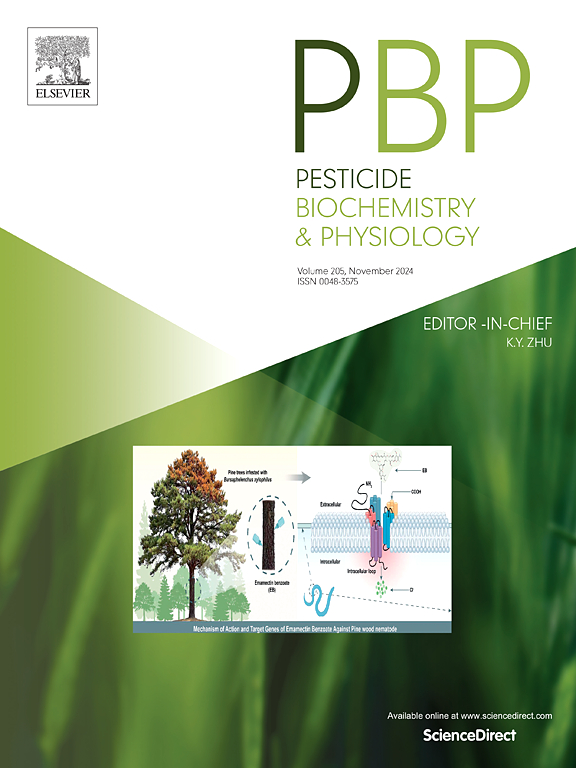The insecticidal toxicity of thymol and carvacrol to brown planthopper and the novel control strategy based on their disruption of the cuticular hydrophobicity
IF 4.2
1区 农林科学
Q2 BIOCHEMISTRY & MOLECULAR BIOLOGY
引用次数: 0
Abstract
The brown planthopper (Nilaparvata lugens (Stål)) is a major pest in rice cultivation. Due to its rapid reproduction and quick resistance development, current control strategies rely heavily on chemical insecticides. This has led to resistance in brown planthoppers to various commonly used insecticides. The limitations of traditional chemical control methods highlight the urgent need for environmentally friendly and sustainable alternatives. This study evaluated the contact toxicity, fumigant toxicity, and spray treatment effects of thymol, carvacrol, and five other volatile compounds against N. lugens nymphs. Results showed that thymol and carvacrol exhibited the strongest insecticidal effects. Both the two compounds, derived from plant essential oils, are low in toxicity and significantly disrupted the hydrophobicity of the nymphs' cuticles, converting them from hydrophobic to hydrophilic. Spray experiments further confirmed their insecticidal efficacy, and rinsing N. lugens after spray treatment with both compounds significantly increased N. lugens mortality rate. GC–MS analysis revealed interactions between carvacrol and cuticular hydrophobic compounds, such as octyl palmitate. These findings suggest that thymol and carvacrol could serve as effective green bioinsecticides by targeting the cuticle and internal compounds of N. lugens. In this study, a novel pest control strategy for rice field pests such as N. lugens was proposed, aiming to disrupt their cuticular hydrophobicity, thereby preventing them from escaping when falling into water and leading to drown in the field water. This method holds promise for significantly reducing the dependence on toxic pesticides and lowering pesticide usage.

百里香酚和香芹酚对褐飞虱的杀虫毒性及基于其破坏褐飞虱表皮疏水性的新防治策略
褐飞虱(Nilaparvata lugens, stamatl)是水稻种植中的主要害虫。由于其快速繁殖和快速抗性发展,目前的控制策略严重依赖化学杀虫剂。这导致褐飞虱对各种常用杀虫剂产生抗药性。传统化学防治方法的局限性突出了对环境友好和可持续替代方法的迫切需要。本研究评价了百里香酚、香芹酚和其他5种挥发性化合物对褐飞虱若虫的接触毒性、熏蒸毒性和喷雾处理效果。结果表明,百里香酚和香芹酚的杀虫效果最强。这两种化合物都是从植物精油中提取的,毒性低,并且显著破坏了若虫角质层的疏水性,使其从疏水性转变为亲水性。喷雾实验进一步证实了两种化合物的杀虫效果,两种化合物喷淋处理后对褐飞虱的冲洗均显著提高了褐飞虱的死亡率。GC-MS分析揭示了香芹酚与表皮疏水化合物(如棕榈酸辛酯)之间的相互作用。这些结果表明,百里香酚和香芹酚可以作为有效的绿色生物杀虫剂,其作用靶点是绿原菌的角质层和内部化合物。本研究提出了一种新的稻田害虫防治策略,其目的是破坏褐飞虱等稻田害虫的表皮疏水性,从而防止它们在落水时逃逸,从而导致稻田水中溺水。该方法有望显著减少对有毒农药的依赖,降低农药使用量。
本文章由计算机程序翻译,如有差异,请以英文原文为准。
求助全文
约1分钟内获得全文
求助全文
来源期刊
CiteScore
7.00
自引率
8.50%
发文量
238
审稿时长
4.2 months
期刊介绍:
Pesticide Biochemistry and Physiology publishes original scientific articles pertaining to the mode of action of plant protection agents such as insecticides, fungicides, herbicides, and similar compounds, including nonlethal pest control agents, biosynthesis of pheromones, hormones, and plant resistance agents. Manuscripts may include a biochemical, physiological, or molecular study for an understanding of comparative toxicology or selective toxicity of both target and nontarget organisms. Particular interest will be given to studies on the molecular biology of pest control, toxicology, and pesticide resistance.
Research Areas Emphasized Include the Biochemistry and Physiology of:
• Comparative toxicity
• Mode of action
• Pathophysiology
• Plant growth regulators
• Resistance
• Other effects of pesticides on both parasites and hosts.

 求助内容:
求助内容: 应助结果提醒方式:
应助结果提醒方式:


